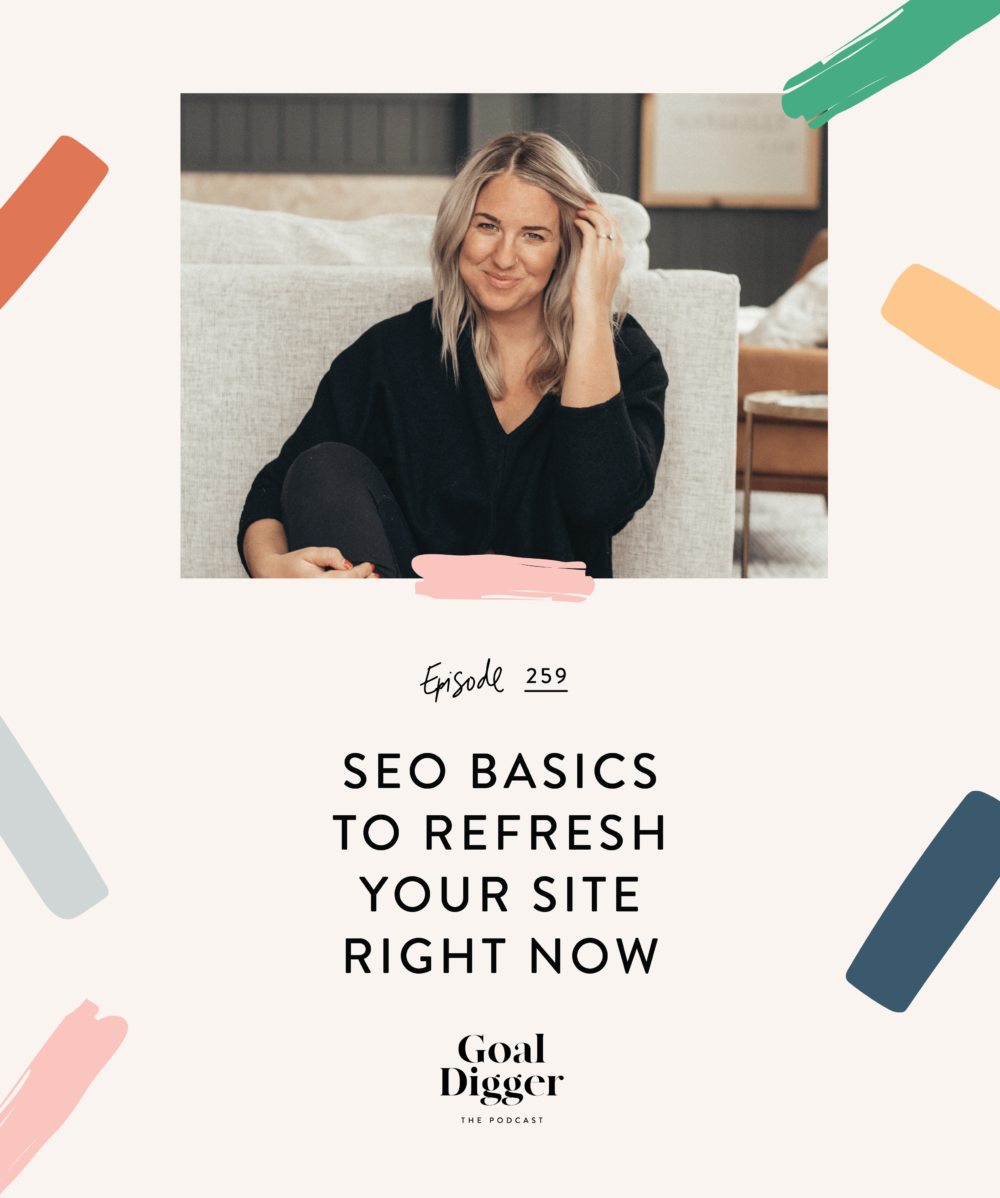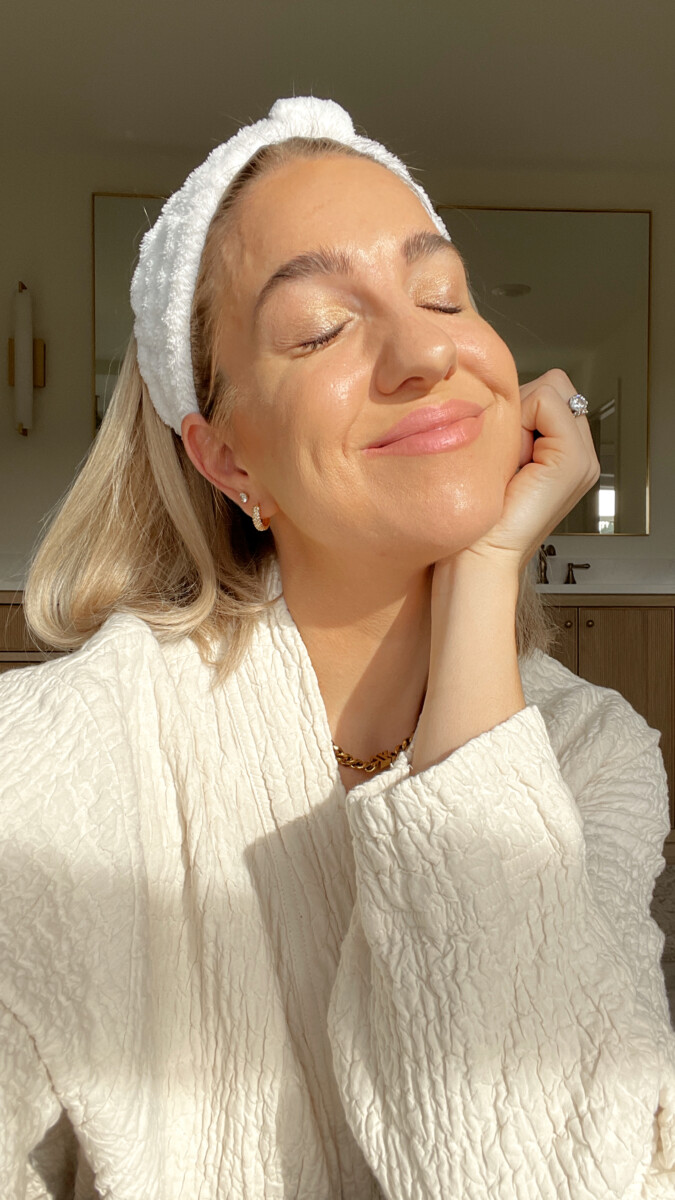
SE-Oh no, what does it all mean?
Search Engine Optimization, the beast we all have to tame if we want our content to get seen on the world wide web. And best case scenario our content isn’t only SEEN, but it’s ranked high up on that Google results page and gets those coveted clicks.
I’ve covered SEO on the show before but I’m seeing the question pop up more and more ‘cause it’s just one of those things that continues to challenge us, confuse us, and keep us from even starting.
The Google algorithm judges our pages with over 200 different criteria — Trying to master them all would be a full time job, and you’ve got bigger things to do. So what will actually move the needle? How can you rank ahead of your competitors? What’s worth the fuss? It’s all in this episode. Press play on the player above!
Quick Review
Just to review quickly so we’re all on the same page, Search Engine Optimization is simply the process of maximizing the number of visitors to our website by using strategies and practices to make sure your site appears high on the list when someone searches for a business like yours.
In the last SEO episode, (again if you didn’t listen to that one, scroll on back or go to jennakutcherblog.com/SEO and tune in so you’re caught up to speed!) I taught you about installing the SEO by Yoast plug-in to your site and walked you through what everything meant and what you need to enter, where. It’s the easiest way I know how to optimize a blog post.
We’re not delaying this information, I’m diving right in! To pick up where we left off (and as a review) each post you publish to drive results in the search engines will need:
A keyword: What you think your audience will be searching for that you want the search engine to show your content in the results.
An SEO Title: This is different than the blog post title. The blog post title is what is shown publicly to your audience, and the SEO title is what search engines will use to determine what the post is about.
A Slug: This is the actual link to your post and you can infuse keywords here to further your SEO strategy
Meta description: This is the first few lines of text under your blog post title that will show up in search results (we’ll dive even deeper into this in this episode)
Alt text: This is the text that is tied to an image and can provide additional information about the image and what the post is about.
All of these pieces fit together to tell the search engines what your content is about. If you’re needing more in depth descriptions and a step by step process, head over to episode 177.
How are you measuring your progress?
I always talk about progress not perfection — because moving forward is better than staying paralyzed or waiting until things are perfect. But how do we know if we’re making progress? Just like anything in business, we need data to really analyze what’s working for you and what’s not working. If you aren’t measuring anything, let’s start there before we look at how you can grow.
First, you want to install Google Analytics for your site to track your success and know what’s working and what’s not. It’s super important that you don’t skip this step and get it done as soon as possible because you can’t get data for the past — I repeat, you can’t get data from the past so every day you delay this step is another day you’re not able to track what’s happening with your site and traffic.
Could you tell me with confidence that what you’re currently doing really works and back that up with numbers and data? If the answer to that is no, let’s fix it by getting you all set up on Google Analytics and then look at where your strategy is working, where it’s not really moving the needle, and then figure out how we can optimize it all – get it? Search engine OPTIMIZATION?
With Google Analytics, you can get really detailed with reporting and setting up goals and advanced strategies, but even just signing up and collecting data on who is visiting your site and where they are coming from can a simple but incredibly effective place to start. Questions about analytics numbers you need to know in your business? I wrote a blog post all about them!
If you’re wondering how to sign up for Google Analytics, here’s how to do it in a 30 second, watered down explanation: Visit analytics.google.com (you’ll need a gmail address and you must own your own website so that you can install a tracking code). There are a ton of how-to articles and YouTube videos on this for your specific type of hosting and site circumstance, so just head to Google and type in Google Analytics and your platform (Squarespace, WordPress, ShowIt etc.) Walk through the steps, install the code, and start tracking! It takes just a few minutes to set this up.
Your Page Needs to Load Quickly
Have you ever clicked to a site, one you were excited about, and it took FOREVER to load… Like you’re checking to make sure you’re still on wifi and you’re hitting refresh incessantly and wondering if the internet went down because surely, it can’t take this long to load a page? Yeah, we’ve all been there and we’ve likely given up and moved on because our patience is equivalent to the patience of a toddler.
Once you’ve got your tracking set up for Google Analytics, let’s take a look at how fast your site is performing. In today’s world, people will not wait for a page to load. So before you even think about adding new SEO strategies, let’s get back to basics and take a look at how your site is currently functioning and how quickly it’s loading. Time spent making sure things are running efficiently is going to be one of the best things you can do for your SEO efforts.
Visit Google PageSpeed Insight and this site will test your site speed and give you suggestions for speeding up your specific site. You can also get at this information within Google Analytics under “Site Speed”. Simply enter your website URL on the Google PageSpeed Insight page and it will analyze it and give you a score as well as let you know how you measure up to other similar pages and give you opportunities on how to improve your page.
If it’s loading slow, check out your plugins — these are things you’ve usually added to add more functionality to your site — it’s easy to forget about them or forget that you might not need old ones. If that’s the case, uninstall any unused plug-ins that are cluttering up your site. These can get outdated and bog down the loading speeds.
Lastly, make sure your images are not sized too large, the larger file sizes will take longer to load. I use programs called JpegMini and BlogStomp to optimize all images for my blog so they still are crisp and clear but they aren’t giant files that take a decade to load.
If this sounds overwhelming or confusing to you, this may be something for you to outsource and get help from experts on because there are a ton of technical ways you can speed your site up, we just want to give you the basics to get to work. Check out your diagnostics and the recommendations and determine if this is an area you could use help with or something you can confidently tackle on your own!
Outbound Links
Yup, my next tip is to quote and link to other resources online. Wait, what? You want me to send people to other businesses after I’ve worked so hard to get them to land on MY site? Yes, and here’s why. Think for a second about how Google works and it’s intention: Google wants to provide its users with the most relevant and authoritative websites for any given search query. Therefore, when we link to another site with great information related to what you’re talking about, whether that’s another page on your site or someone else’s, you are adding value to the page and to the readers.
These are called outbound links in SEO terminology and if you listened to my first SEO episode, I recommended installing a plug-in called SEO by Yoast. This plug-in allows you to easily enter the necessary information for SEO for each post and then will it will grade your post on if it’s optimized well for search engines with a green meaning (best), yellow meaning (ok) and red meaning (bad) and then will give you tips for how to improve the post from an SEO standpoint.
One of their main recommendations is always “add an outbound link to your content”.
Each of your posts should include some sort of outbound link — a link to an extra resource or site or an extra invitation to keep learning about what the post was about, you don’t want to throw in a random link for the sake of this point. Only link to another person’s site if it’s truly adding value to your post and it should go without saying that we are extremely picky about the sites we choose to link to. This is like attaching our name and my brand to another business and it is a reflection of our brand.
When we link to another site, we always make sure to have our outbound links pop up in a new window. I’m OK with pointing people to another resource if it’s helpful, and citing sources is necessary! When you outbound, you can also be smart about how you’re sending traffic to another page — which is why we have it load in a new window so we aren’t sending traffic away from our site permanently. The goal is to make sure people can easily navigate back to the page they were initially reading on our page.
This strategy also helps create and foster community which you guys know I’m a big fan of. Outbound links help other businesses with their SEO as well. It helps provide a valuable resource to our reader and supports another business in our industry, win win!
Inbound Links
Now, this tip doesn’t just start and stop with your own content, if other businesses include outbound links to your site, that is huge for your SEO too. These are called inbound links or backlinks. So to reiterate, if people are linking to your content in theirs, it’s called an inbound link meaning they are sending traffic in to your site and this helps boost your credibility on the Google Analytics scale, and when you link to another site or page in your own posts, that’s an outbound link.
Here are three ways you can obtain inbound links to your site: Join any local member directories whether that’s a chamber of commerce or business association where your business will be linked. Write high quality guest post content or interviews for another site with a link back to your own space on the web. And finally, write a testimonial and share a comment on a post and link back to your site in your comments.
Broken Links
Even though we have extremely high standards in my business, it seems like every other month someone is writing to say a link is broken that we need to fix or that something isn’t loading correctly. This happens so easily and it’s so important that we fix these and address broken links as soon as they come up.
These might not even be broken links that you’re responsible for — maybe a business you linked to 3 years ago changed it’s name or has a new URL. Maybe you had a seasonal campaign and forgot to update the link for the sales page that is no longer live. Broken links on a site not only disrupt the user experience but it also shows Google that the site is neglected or abandoned and will affect your search rankings. Broken links can tip Google off that you’re sending people to the wrong content or content that isn’t relevant and impact your SEO.
There are a few sites and plug-ins out there that can help you with finding broken links like Monster Insights or the plug-in “Broken Link Checker”. If you’ve never done this before, it can be a time consuming process but one that’s worthwhile. I recommend checking in on your broken links every couple of months to make sure you’re staying on top of things and immediately fix anything that is brought to your attention to keep your link game strong.
Meta Description Version 2.0
We talked about this at length in the last SEO episode, but it’s worth digging in a little deeper here. Far too often businesses will write their meta description for search engines instead of for actual people — trust me, you’ve experienced this.
Like when you land on a website and it says: Wisconsin wedding photographer, Milwaukee wedding photographer, Madison wedding photographer, Wisconsin wedding photography — like a list of 50 things that all say the same-ish thing and it’s super hard to read and weird and doesn’t help you as a consumer and you wonder if someone messed something up?
Your Meta Description should be written for your consumer, not for Google. It’s important that this piece of information is written with the intent of getting someone to actually click through to your page to learn more.
Remember, this is the first few lines that will show up under the title of your post, giving someone who is searching for what you’re talking about — more information to be able to determine if yours is the article they want to click through to. It doesn’t matter if we achieve page one rankings if people don’t click through or think ours is the right resource for them.
Best practices state that your keyword needs to be as early in the meta description as possible. Do your best here, but don’t force it. What I’m most worried about is a strong call to action and words that will reveal to the person that your article is what they were searching for. I always say, writing the subject line, post title or call to action for your content should take almost as long as writing the content itself! A lot of people spend so much time on the content that they forget the pieces that help people actually get to the point of consuming it: the title is a big one!
It’s tempting to just take the easy route and load keywords into the meta description of your post to get that SEO by Yoast green light of approval and call it a day, but trust me, going the extra mile here is going to payoff in terms of traffic, so slow down and think through this step and what will actually entice someone to click through and read your content.
So, what makes up a good meta description?
- Focus keyword
- 155 characters or less
- A call to action
- Written in an active voice
- Having the description match the content in the post
- The meta description is unique to the page it’s linked to
The goal here is the most refined, condensed explanation of what they will get – the promise or the solution the content will lead someone to shared in a concise way. We need to be able to tell people in 2 sentences or less what they will learn by reading the article and why it’s important to them.
Coming Up with Keywords
Again, we covered keywords in the last episode, but now I want to cover how I actually come up with keywords for my business and another strategy to benefit from keywords if you’re in a really competitive industry.
My favorite keyword research tool is: Pinterest. The thing is, Pinterest is a search engine and not a social media platform and there is so much insight into what people are searching for right under our noses of this platform. We do a ton of research for our SEO and for our content creation in general using Pinterest. It’s an easy way to see what people are searching for, what topics are resonating, what terms they are using.
Last episode I had you pick 5 or so keywords to get started with and focus on. Now I want you to take each of those 5 words and write them in the guided search bar of Pinterest. Pinterest then auto-populates the 5 most common searches with that term in it for you. So for example, if I write “starting a business”, Pinterest finishes that search with the following terms: checklist, with no money, quotes, from home.
They just gave you four of the things people are searching for the most — is this blowing your mind? Pinterest is not just good at helping you build your dream closet or pick out your next hairstyle, it does a lot of the work for you when it comes to choosing keywords that get clicked on.
This doesn’t just stop at Pinterest, this same strategy works in Google.
You might be thinking, okay, but “Starting a business with no money” seems like a really long phrase and not really a “keyword”. Here’s my next tip for you: if your keyword is a common one that might be difficult to rank for, consider long-tailed keywords.
Long-tailed keywords are a phrase that contain more than 3 words and they are used to target a very specific niche and can often be less competitive than generic keywords. So instead of relying on just one word, you’re relying on a phrase that people might be searching for. Check the Google Adwords Keyword Planner for more keyword help. With this site you can put in your main keyword and it will tell you options for words you can add to it and provide you with more information like how competitive that keyword is.
Another site I love is Neil Patel’s Uber Suggest. You can take the list you’ve been working with and compiling and put keywords into his search bar and it will auto-generate additional combinations of words and give you more ideas and suggestions!
One final place we go to research keywords is called the Google Webmasters account. This will show you what people searched for that ultimately landed on your site. It’s an interesting exercise and can provide insight into what’s working and maybe some ideas you didn’t realize people were finding you for that you can capitalize on by answering more directly.Our keyword strategy is always evolving but we focus first on creating great content and the right long-tailed keywords that result from that content that we create with you, the reader in mind. Think to yourself “what would someone be searching for that this content will solve” and use that as your long-tailed keyword.
The Big Picture
Whew, that was a lot of in-depth stuff, right? But my hope is that I was able to break it down in a way that was digestible and actionable so that you can get to work refining your SEO strategy and boosting your ability to be found by your dream clients. It’s not just about praying to the Google Gods that your content will show up, so apply our strategies and tips that we shared here and watch you move on up the google leaderboard.
While SEO is extremely important for our traffic growth and is absolutely something we should prioritize and continue to improve upon for our websites, it is not the end all be all. Do not work so hard on this that you are no longer writing for actual humans and focus on serving your people and instead start to sound like a robot, cold and calculated. Use these strategies to allow you to serve real humans who will be excited to ingest your content and use our research tips to help generate ideas on ways that you can use your gifts and knowledges to show up and bless the world with your content.





[…] More specifically she dives into details around Google Analytics, you can read her show script here or listen to the episode […]
[…] see this as a great thing! Your site becomes more trustworthy. Share related content that you love! Just remember that the focus is to keep users on your site, so don’t have too many links that […]
[…] Episode 259: SEO Basics to Refresh Your Site Right Now […]
This is an amazing blog and good checklist for beginners. A lot of people do struggle with SEO and i hope this can help them with their problems. Highly recommended!
Yesss! Thrilled to hear you enjoyed this post Yash!
This is an amazing blog Jenna. You have an amazing website holistically Btw. and good checklist for beginners. A lot of people do struggle with SEO and i hope this can help them with their problems. Highly recommended!
[…] Episode 259: SEO Basics to Refresh Your Site […]